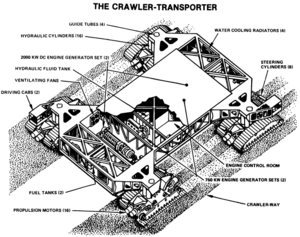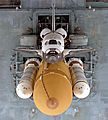Crawler-transporter facts for kids
Quick facts for kids Crawler-transporter |
|
|---|---|
 |
|
| Overview | |
| Manufacturer | Marion Power Shovel Company |
| Also called | Missile Crawler Transporter Facilities |
| Model years | 1965 |
| Powertrain | |
| Engine | 2 × 2,050 kW (2,750 hp) V16 ALCO 251C diesel engines 2 × 750 kW (1,006 hp) generators, driven by two 794 kW (1,065 hp) engines, are used for jacking, steering, lighting, and ventilating. |
| Transmission | 16 × traction motors, powered by four 1,000 kW (1,341 hp) generators |
| Dimensions | |
| Length | 40 m (131 ft) |
| Width | 35 m (114 ft) |
| Height | Adjustable, 6 to 8 m (20 to 26 ft) |
| Weight | 2,721 t (6,000,000 lb) |
|
Missile Crawler Transporter Facilities
|
|
| Location | Kennedy Space Center, Florida |
| MPS | John F. Kennedy Space Center MPS |
| NRHP reference No. | 99001643 |
| Added to NRHP | January 21, 2000 |
The crawler-transporters are giant tracked vehicles. They are used by NASA to move huge spacecraft and rockets. These amazing machines carry rockets from the Vehicle Assembly Building (VAB). They travel along a special road called the Crawlerway to Launch Complex 39.
These crawlers first helped move the Saturn V and Saturn IB rockets. This was during the Apollo missions, Skylab, and Apollo–Soyuz programs. Later, from 1981 to 2011, they moved the Space Shuttles. The crawlers carry the spacecraft on special platforms. After a launch, they return to pick up the platform and bring it back to the VAB.
Two crawler-transporters were built by the Marion Power Shovel Company. Each cost about $14 million. When they were built, they were the biggest self-powered land vehicles in the world. They were added to the National Register of Historic Places in 2000.
Contents
How Crawler-Transporters Work
Each crawler-transporter weighs about 2,721 tons. That's like 1,360 cars! They have eight tracks, two on each corner. Each track has 57 "shoes," and each shoe weighs about 900 kilograms (1,984 pounds).
The vehicle is about 40 meters (131 feet) long and 35 meters (114 feet) wide. Its height can change from 6 meters (20 feet) to 8 meters (26 feet). Each side can be raised or lowered separately. This helps keep the Mobile Launcher Platform perfectly level. Even when going up a slope, the platform stays level.
A laser guidance system helps the crawler move precisely. Another laser system helps it park exactly where it needs to be. A team of nearly 30 people operates the crawler. They work from an internal control room and two driver cabs.
Power and Speed
The crawlers got major updates in 2003. They received new engines, brakes, and computer systems. Each crawler has 16 powerful motors. These motors are powered by four generators. Two huge diesel engines drive these generators.
Other smaller engines and generators power things like steering, lights, and ventilation. The crawlers can hold about 18,927 liters (5,000 US gallons) of diesel fuel. They use a lot of fuel, about 296 liters per kilometer (125.7 US gallons per mile).
One crawler, called CT-2, was upgraded in 2012. This "Super Crawler" can lift even heavier loads. Its lifting capacity increased from 5.4 million kg to 8.2 million kg.
The Crawlerway Road
The crawlers travel on special roads called Crawlerways. There are two main Crawlerways, one for each launch pad. They are about 5.5 kilometers (3.4 miles) and 6.8 kilometers (4.2 miles) long.
The crawlers move very slowly. Their top speed is about 1.6 kilometers per hour (1 mph) when carrying a rocket. Without a load, they can go up to 3.2 kilometers per hour (2 mph). A trip from the VAB to the launch pad takes about five hours.
The Crawlerways are 2.1 meters (7 feet) deep. They are covered with special river rock. This rock helps prevent sparks.
History and Future
NASA has used the same two crawlers since 1965. They are nicknamed "Hans" and "Franz." Together, they have traveled over 5,472 kilometers (3,400 miles). That's like driving from Miami to Seattle!
NASA plans to use one of the crawlers for the new Space Launch System. This rocket will carry the Orion spacecraft. It is part of the Artemis program.
In 2016, crawler-transporter 2 (CT-2) was fully upgraded to be the "Super Crawler." It will be used for the Artemis missions. The other crawler, CT-1, is being changed to help with commercial spacecraft launches.
Images for kids
-
Crawlerway junction at the LC-39 observation gantry. The right track leads to pad LC-39A (pictured with Space Shuttle Endeavour), while the left track leads to pad LC-39B.
-
Space Shuttle Atlantis atop an MLP (and crawler beneath)
-
A crawler-transporter carrying Discovery (STS-114) travels the ramp to Launch Pad 39B. The vehicle's back end can be raised, keeping the Shuttle and the MLP level.
-
Space Shuttle Challenger atop an MLP atop a crawler, in transit to its launch pad prior to its final flight, January 28, 1986
- 28°35′17″N 80°39′19″W / 28.58808°N 80.65521°W - Crawler-transporter parking area at Kennedy Space Center
See also
 In Spanish: Transporte de orugas (NASA) para niños
In Spanish: Transporte de orugas (NASA) para niños








